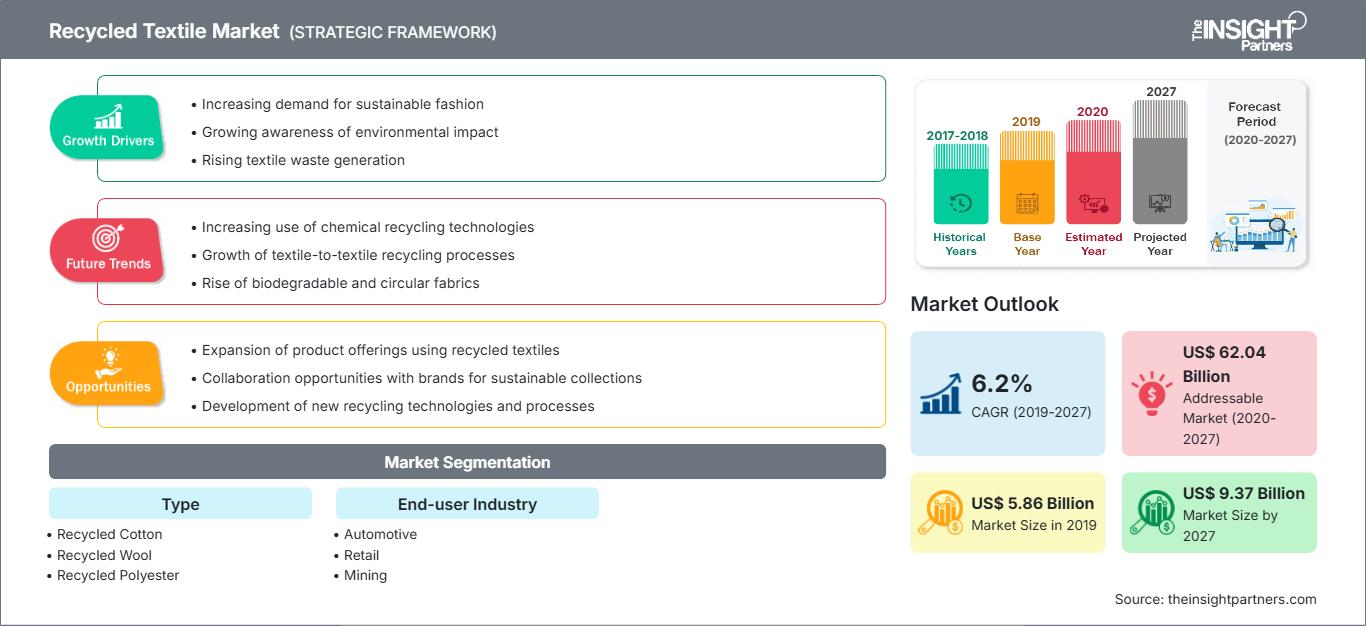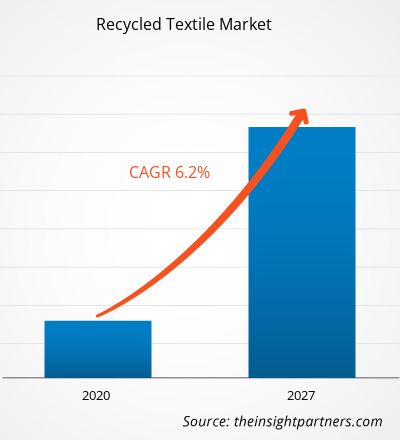2019 年再生纺织品市场价值为 58.5539 亿美元,预计到 2027 年将达到 93.6504 亿美元;预计 2020 年至 2027 年的复合年增长率为 6.2%。
再生纺织品是指旧衣服或其他未使用的纺织品,可以回收再利用或进行材料回收。近年来,全球范围内对纺织废料处理问题的担忧日益加剧,因为这可能会对环境造成负面影响。全球对再生纺织品的需求不断增长,服装、面料、汽车等多个终端使用行业的需求激增。制造商采用多种技术将旧纺织品回收成更好的产品,这些产品可用于各种终端使用行业。资源回收主要借助热处理、机械和化学技术。
由于欧洲各国政府的举措不断增多,欧洲已成为再生纺织品的重要市场。此外,汽车行业对再生纺织品的需求不断增长,为再生纺织品市场参与者提供了丰厚的商机。购买力的提高加上生活方式的改变是欧洲地区纺织品市场增长的主要驱动因素之一。在欧洲,近 15% 的消费者旧衣服被回收利用,而超过 75% 的未使用过的衣服被制造商回收用于工业用途。过去几年,欧洲对再生纺织品的需求增长速度最快。再生纺织品生产商主要关注德国、英国等国家,这导致欧洲地区对再生纺织品的需求巨大。消费者对循环纺织经济的日益关注也有望在更大程度上推动该地区的市场增长。
截至 2020 年 8 月,美国、巴西、印度、俄罗斯、南非、墨西哥、西班牙和英国是确诊病例和报告死亡人数最多的国家。由于封锁、旅行禁令和企业倒闭,COVID-19 已影响到各国的经济和工业。全球化工和材料行业是受新冠疫情影响,供应链中断、生产中断等严重影响的主要行业之一。例如,中国是全球制造业中心,也是各行各业最大的原材料供应国。中国以及亚太地区和欧洲等主要地区的多家工厂的停工,正在影响全球供应链,并对各种商品的生产、交付进度和销售造成负面影响。所有这些因素都极大地影响了全球再生纺织品市场。
自定义此报告以满足您的要求
您将免费获得任何报告的定制,包括本报告的部分内容,或国家级分析、Excel 数据包,以及为初创企业和大学提供超值优惠和折扣
再生纺织品市场: 战略洞察

- 获取本报告的主要市场趋势。这个免费样本将包括数据分析,从市场趋势到估计和预测。
市场洞察:纺织废料处理问题日益受到关注
您将免费获得任何报告的定制,包括本报告的部分内容,或国家级分析、Excel 数据包,以及为初创企业和大学提供超值优惠和折扣
再生纺织品市场: 战略洞察

- 获取本报告的主要市场趋势。这个免费样本将包括数据分析,从市场趋势到估计和预测。
纺织品制造机制被认为是化学密集型过程之一,在整个运营过程中会产生大量纺织废料。纺织废料可分为两类:消费前纺织废料和消费后纺织废料。纺织废料数量的增加给环境带来了负担,并带来了现有垃圾填埋场有效处置或焚烧的问题。据估计,所有未使用的纺织品中约有 10% 到 20% 被认为是浪费。例如,根据美国环保署的数据,2015 年,共产生了 1575 万吨纺织品作为城市固体废物,其中 19% 被焚烧,65% 最终进入垃圾填埋场。此外,美国环境保护署的一份报告表明,纺织品的生产和处置会导致温室气体排放。此外,焚烧过程会排放重金属、二恶英、酸性气体和粉尘颗粒等有机物质,这些物质对人类和环境都有害。此外,由于残留灰烬中含有高浓度的有毒物质,其处理也已成为一个严峻的问题。因此,通过再利用或回收利用的方法有效地管理纺织废料至关重要,这有助于促进环境的可持续发展。在这种情况下,回收纺织废料被认为是一种可行的替代方案,有助于减轻自然资源的负担,最大限度地减少对垃圾填埋场的需求,并有助于节约能源。此外,政府出台的严格立法规范了纺织废料的有效管理,其目的可能是为了推广纺织品回收利用,将其作为一种可持续的替代方案,以解决迫在眉睫的废料问题。
类型洞察
根据类型,再生纺织品市场细分为再生棉、再生羊毛、再生聚酯纤维、再生尼龙等。预计再生尼龙市场在2019-2027年的预测期内将以最快的速度增长。再生尼龙由工业塑料、废纤维、织布厂的废弃物以及消费后渔网制成。它们被再生成新的尼龙,其品质与原生尼龙相同。尼龙袋、尼龙织物和尼龙地毯也被转化为再生尼龙以供进一步利用。很大一部分再生尼龙来自渔网。这是转移海洋垃圾的绝佳解决方案。与尼龙相比,回收尼龙的成本更高,但它具有许多环境效益。通过回收尼龙,人们可以消除废弃物并减少制造过程中的温室气体排放。它减少了对石油作为原材料来源的依赖。使用再生尼龙还有助于推广不再使用的尼龙产品的新回收流程。大多数机械回收材料在高温下熔化,最终会破坏污染物并将其转化为可重复使用的形式。尼龙在回收过程中会在低温下熔化,留下污染物。因此,尼龙在回收前需要仔细清洗。
终端用户行业洞察
根据终端用户行业,再生市场细分为汽车、零售、采矿等。预计在2019-2027年的预测期内,汽车行业将以最快的速度增长。再生纺织品用于汽车行业,并在汽车零部件生产中发挥着重要作用。再生纺织品在汽车应用中的应用包括可见部件,如地板覆盖物、内饰、安全带,以及不可见的再生纺织品,如管子和胶带、轮胎帘线、安全气囊组件和纤维。再生纺织品因其抗拉强度、耐磨性、透气性、抗压性、弹性、易于清洁、阻燃性和耐动态气候条件性而用于汽车行业。再生棉用于座椅填料或汽车隔热材料。
Anandi Enterprises、Chindi、Khaloom Textile India Pvt.有限公司、Kishco集团等是全球再生纺织品市场的主要参与者。这些公司正在实施新产品开发和并购战略,以扩大客户群并在全球范围内获得显著的市场份额,从而使这些参与者能够在全球范围内维护其品牌声誉。
再生纺织品市场再生纺织品市场
The Insight Partners 的分析师已详尽阐述了预测期内影响再生纺织品市场的区域趋势和因素。本节还探讨了北美、欧洲、亚太地区、中东和非洲以及南美和中美洲的再生纺织品市场细分和地域分布。
再生纺织品市场报告范围
| 报告属性 | 细节 |
|---|---|
| 市场规模 2019 | US$ 5.86 Billion |
| 市场规模 2027 | US$ 9.37 Billion |
| 全球复合年增长率 (2019 - 2027) | 6.2% |
| 历史数据 | 2017-2018 |
| 预测期 | 2020-2027 |
| 涵盖的领域 |
By 类型
|
| 覆盖地区和国家 | 北美
|
| 市场领导者和主要公司简介 |
|
再生纺织品市场参与者密度:了解其对商业动态的影响
再生纺织品市场正在快速增长,这得益于终端用户需求的不断增长,而这些需求的驱动因素包括消费者偏好的不断变化、技术进步以及对产品优势的认知度不断提高。随着需求的增长,企业正在扩大产品线,不断创新以满足消费者需求,并抓住新兴趋势,从而进一步推动市场增长。

- 获取 再生纺织品市场 主要参与者概述
- 全球再生纺织品市场不断发展的行业趋势有助于参与者制定有效的长期战略
- 发达市场和发展中市场采用的业务增长战略
- 2017 年至 2027 年全球再生纺织品市场的定量分析
- 估计各行业全球再生纺织品需求
- PEST 分析,说明行业买家和供应商预测市场增长的有效性
- 了解竞争激烈的市场形势和全球再生纺织品需求的最新发展
- 市场趋势和前景,以及推动和抑制全球再生纺织品市场增长的因素
- 通过了解支撑全球再生纺织品市场增长的商业利益的策略来进行决策过程
- 全球再生纺织品市场在各个市场节点的规模。
- 全球再生纺织品市场的详细概述和细分,以及其行业动态
- 全球再生纺织品市场在各个地区的规模,增长前景看好机遇
全球再生纺织品市场(按类型)
- 再生棉花
- 再生羊毛
- 再生聚酯
- 再生尼龙
- 其他
全球再生纺织品市场(按最终用户)工业
- 汽车
- 零售
- 采矿
- 其他
公司简介
- Anandi Enterprises
- Chindi
- Khaloom Textile India Pvt.有限公司
- Kishco集团
- Usha Yarns Limited
- 晓星公司
- Leigh Fibers Inc.
- Martex Fiber Southern Corporation
- Renewcell AB
- Boer Group
- 历史分析(2 年)、基准年、预测(7 年)及复合年增长率
- PEST和SWOT分析
- 市场规模、价值/数量 - 全球、区域、国家
- 行业和竞争格局
- Excel 数据集
近期报告
客户评价
购买理由
- 明智的决策
- 了解市场动态
- 竞争分析
- 客户洞察
- 市场预测
- 风险规避
- 战略规划
- 投资论证
- 识别新兴市场
- 优化营销策略
- 提升运营效率
- 顺应监管趋势






















 获取免费样品 - 再生纺织品市场
获取免费样品 - 再生纺织品市场